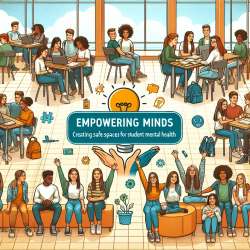Empowering Minds: Creating Safe Spaces for Student Mental Health
In today's fast-paced world, the mental health of students has become a critical area of focus for educators and policymakers. Schools are increasingly recognizing the importance of fostering a supportive environment that addresses the emotional, psychological, and social well-being of students. This blog delves into the comprehensive approach outlined in the Student Mental Health Protocol Model Policy Guidance, which serves as a beacon for schools striving to create safe spaces for student mental health.
The Foundation: Understanding Mental Health
Mental health is a multifaceted concept that encompasses emotional, psychological, and social well-being. It influences how individuals handle stress, relate to others, and make choices. Recognizing the signs of a mental health crisis is the first step in providing timely and effective support. Warning signs such as changes in school performance, withdrawal from social interactions, and unexplained physical symptoms can indicate the need for intervention.
Building a Culture of Safety and Support
Creating a culture of safety and support within schools is paramount to safeguarding student health. By fostering healthy relationships built on trust, respect, and care, schools can enhance student-teacher relationships, increase engagement, and improve communication. This positive environment replaces fear and uncertainty with belonging and connectedness, encouraging students to seek help when needed.
Crisis Response: Preparedness and Action
Effective crisis response requires advance planning and swift action. Schools must establish protocols to address mental health crises, ensuring compliance with privacy requirements such as FERPA and HIPAA. In a crisis, staff should assess the situation, engage with the student calmly, and involve trained professionals as needed. The 988 Mental Health Lifeline and local Certified Community Behavioral Health Clinics are invaluable resources for immediate support.
Partnerships and Training: A Collaborative Approach
Collaboration with community mental health partners is essential for a robust crisis response strategy. Schools should establish working agreements with mental health providers to ensure a coordinated approach. Additionally, regular training for educators on recognizing warning signs and accessing resources is crucial. This training empowers staff to support students effectively and contribute to a safer school environment.
Student Return to Learn: Easing Transitions
After a mental health crisis, a well-structured re-entry plan is vital for students returning to school. Meetings with parents, guardians, and students help ease the transition, address concerns, and establish accommodations. Regular check-ins with students and communication with faculty ensure ongoing support and adjustment to the school community.
Conclusion
The Student Mental Health Protocol Model Policy Guidance provides a comprehensive framework for schools to support student mental health. By recognizing warning signs, fostering a culture of safety, and collaborating with community partners, schools can create an environment where students thrive. For more information, please follow this link.










